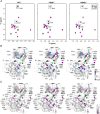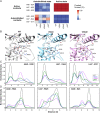Gatekeeper mutations activate FGF receptor tyrosine kinases by destabilizing the autoinhibited state
- PMID: 36791110
- PMCID: PMC9974468
- DOI: 10.1073/pnas.2213090120
Gatekeeper mutations activate FGF receptor tyrosine kinases by destabilizing the autoinhibited state
Abstract
Many types of human cancers are being treated with small molecule ATP-competitive inhibitors targeting the kinase domain of receptor tyrosine kinases. Despite initial successful remission, long-term treatment almost inevitably leads to the emergence of drug resistance mutations at the gatekeeper residue hindering the access of the inhibitor to a hydrophobic pocket at the back of the ATP-binding cleft. In addition to reducing drug efficacy, gatekeeper mutations elevate the intrinsic activity of the tyrosine kinase domain leading to more aggressive types of cancer. However, the mechanism of gain-of-function by gatekeeper mutations is poorly understood. Here, we characterized fibroblast growth factor receptor (FGFR) tyrosine kinases harboring two distinct gatekeeper mutations using kinase activity assays, NMR spectroscopy, bioinformatic analyses, and MD simulations. Our data show that gatekeeper mutations destabilize the autoinhibitory conformation of the DFG motif locally and of the kinase globally, suggesting they impart gain-of-function by facilitating the kinase's ability to populate the active state.
Keywords: NMR spectroscopy; molecular dynamics; receptor tyrosine kinases.
Conflict of interest statement
The authors declare no competing interest.
Figures








Similar articles
-
The role of fibroblast growth factor receptor (FGFR) protein-tyrosine kinase inhibitors in the treatment of cancers including those of the urinary bladder.Pharmacol Res. 2020 Jan;151:104567. doi: 10.1016/j.phrs.2019.104567. Epub 2019 Nov 23. Pharmacol Res. 2020. PMID: 31770593 Review.
-
Illuminating the molecular mechanisms of tyrosine kinase inhibitor resistance for the FGFR1 gatekeeper mutation: the Achilles' heel of targeted therapy.ACS Chem Biol. 2015 May 15;10(5):1319-29. doi: 10.1021/acschembio.5b00014. Epub 2015 Feb 24. ACS Chem Biol. 2015. PMID: 25686244 Free PMC article.
-
A novel mode of protein kinase inhibition exploiting hydrophobic motifs of autoinhibited kinases: discovery of ATP-independent inhibitors of fibroblast growth factor receptor.J Biol Chem. 2011 Jun 10;286(23):20677-87. doi: 10.1074/jbc.M110.213736. Epub 2011 Mar 24. J Biol Chem. 2011. PMID: 21454610 Free PMC article.
-
Systematic Analysis of Tyrosine Kinase Inhibitor Response to RET Gatekeeper Mutations in Thyroid Cancer.Mol Inform. 2016 Oct;35(10):495-505. doi: 10.1002/minf.201600039. Mol Inform. 2016. PMID: 27712045
-
Exploration of structural requirements for the inhibition of VEGFR-2 tyrosine kinase: Binding site analysis of type II, 'DFG-out' inhibitors.J Biomol Struct Dyn. 2022 Aug;40(12):5712-5727. doi: 10.1080/07391102.2021.1872417. Epub 2021 Jan 18. J Biomol Struct Dyn. 2022. PMID: 33459187 Review.
Cited by
-
Polypeptide Substrate Accessibility Hypothesis: Gain-of-Function R206H Mutation Allosterically Affects Activin Receptor-like Protein Kinase Activity.Biomolecules. 2023 Jul 14;13(7):1129. doi: 10.3390/biom13071129. Biomolecules. 2023. PMID: 37509165 Free PMC article.
-
Can Deep Learning Blind Docking Methods be Used to Predict Allosteric Compounds?J Chem Inf Model. 2025 Apr 14;65(7):3737-3748. doi: 10.1021/acs.jcim.5c00331. Epub 2025 Apr 1. J Chem Inf Model. 2025. PMID: 40167386 Free PMC article.
-
Mechanisms of resistance to tyrosine kinase inhibitor-targeted therapy and overcoming strategies.MedComm (2020). 2024 Aug 24;5(9):e694. doi: 10.1002/mco2.694. eCollection 2024 Sep. MedComm (2020). 2024. PMID: 39184861 Free PMC article. Review.
-
Spatial and signaling overlap of growth factor receptor systems at clathrin-coated sites.Mol Biol Cell. 2024 Nov 1;35(11):ar138. doi: 10.1091/mbc.E24-05-0226. Epub 2024 Sep 18. Mol Biol Cell. 2024. PMID: 39292879 Free PMC article.
-
Perspectives on Computational Enzyme Modeling: From Mechanisms to Design and Drug Development.ACS Omega. 2024 Feb 8;9(7):7393-7412. doi: 10.1021/acsomega.3c09084. eCollection 2024 Feb 20. ACS Omega. 2024. PMID: 38405524 Free PMC article. Review.
References
Publication types
MeSH terms
Substances
Grants and funding
LinkOut - more resources
Full Text Sources
Medical

